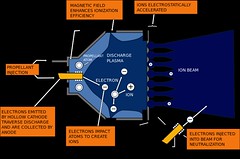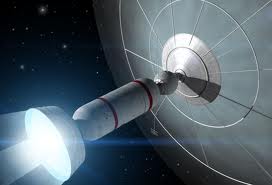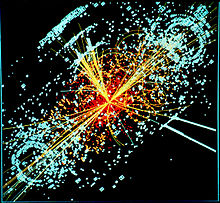
In my last post on this topic (Space Travel) I mentioned that many Sci-Fi authors borrow heavily from naval vessels and aircraft in depicting the behavior of space craft in their writing. And while this sometimes irritates me too, I encouraged authors to write what they dream; don’t pay too much attention to us hard-SciFi’ers, because something is impossible only until someone does it. And humankind has done the impossible many times already.
However, for those who would like to put a more factual edge into their Sci-Fi writings, I will continue to look at some of the specific areas that draw fire by being more science fantasy than science fiction and ways to lessen this by employing currently viable technologies as a starting point at least. This week I want to look at propulsion systems: engines. Because this is a blog post, not a treatise, I’ll need to keep it brief and select the most suitable topics – or serve espresso and cookies with each reading to keep you from wandering off.
Solid Fuel Propulsion
Invented about a thousand years ago in China, solid-fuel rocket engines were the first engines created by mankind and have been used widely ever since. The line about “the rocket’s red glare” in the USA national anthem (written in the early 1800’s) is talking about small military solid-fuel rockets used to deliver incendiary devices. As a kid I (a few years after the national anthem was written) built model rockets using solid fuel “engines” and sent them soaring into the sky. I could even make multi stage rockets with cartridges that would blow out the top as a final act and ignite the next engine in the stack. C130 Hercules aircraft use solid fuel rocket boosters to get heavy loads off the ground on a short runway. And, of course, the Space Shuttle program used solid fueled SRBs to help lift the shuttle into space.
Solid fuel rockets have the advantage of being cheap to make (relatively speaking), simple (no moving parts) and safe (as long as the seals hold). Their disadvantages include the fact that once they’re lit they cannot be shut down, if they go out on their own they cannot be re-lit, and their thrust cannot be controlled in flight (throttled up or down). The fuel charge can be “shaped”, as in the Shuttle’s SRBs, to provide more thrust early in the burn then taper off, but a pilot cannot “hit the gas” to increase thrust.
Still, solid fuel boosters could be used to give a large, heavy ship a boost out of an orbital position toward its destination. The boosters would then be discarded (lightening the ship) and recovered by the orbital facility to be reloaded and used again – or not; if you’re happy with scattering space junk all over the place.
Solid fuel rockets could also be used in weapons systems; missiles and torpedoes.
Liquid Fuel Propulsion
Liquid fueled rockets are the mainstay of our modern space program. Robert Goddard tested the first liquid-propellant rocket engine in 1926. He worked on and solved a number of fundamental problems in rocket engine design, including pumping mechanisms, cooling strategies and steering arrangements. These problems are what make liquid-propellant rockets so complicated.
Aside from being complicated, the biggest problem with liquid fueled rocket engines is the amount of fuel they consume – and the associated weight. Goddard used gasoline and liquid oxygen (LOX) to fuel his experiments, the Germans used alcohol and LOX in their V2 rockets, kerosene and LOX were used in the Apollo Saturn 5 rockets, liquid hydrogen and LOX by the space shuttle and nitrogen tetroxide/monomethyl hydrazine by the Cassini engine. Each is an improvement over its predecessor, but all still suffer the problem of having to lift vast quantities of itself to blast into space. NASA states that using a hydrogen/oxygen fuel to lift a rocket from the surface of the Earth to stable Earth orbit requires a rocket that is 83% fuel and 17% payload/vehicle (by mass).
Once out of Earth’s gravity well, far less fuel is consumed. It takes as much fuel to get off Earth as it does to fly to and land on the surface of Mars. And of course, once a space ship is away from a planet the engines can be turned off and the ship will “coast” until it needs to flip over and decelerate. Traveling around our solar system with chemical rockets is possible – especially if we set up mining bases on asteroids as refueling stations for them – but traveling outside our system, or getting anywhere very fast, will require something more sophisticated.
Nuclear Propulsion
In the 1970s tests were done using a small nuclear reactor to heat hydrogen as a propellant. The results were promising. Thrust is measured as Payment Energy in kilometers per second (km/s). A solid fuel rocket delivers a PE of 3.0 km/s, liquid fuels around 4.5 km/s, but the nuclear rocket delivered a PE of 8.3 km/s! Nearly double the thrust of the best liquid fuel combustion engines.
The biggest problem with this engine is containing the radiation, which required heavy shielding that increases a ship’s mass so much the thrust gain is lost again. If light weight but effective shielding could be developed, this would become an excellent engine for long range space craft. Not only is it powerful, but hydrogen is the most abundant element in the universe. It exists as a free element in outer space, in nebulae and is a component of many asteroids and planetary atmospheres.
Ion Engine
 The Ion engine works in a similar fashion to the ion fans you see around that “blow” air via electrical fields instead of whirling blades. An ion engine produces thrust by tearing apart a large, stable molecule such as xenon, then using magnetic fields to separate positive from negative and accelerate them using electrically charged (magnetic) grids to produce thrust. Once the particles have passed through the acceleration grid, the positive and negative elements find one another and recombine to produce the inert substance again. Check out this NASA/JPL tutorial if you want to dig into the guts of this engine.
The Ion engine works in a similar fashion to the ion fans you see around that “blow” air via electrical fields instead of whirling blades. An ion engine produces thrust by tearing apart a large, stable molecule such as xenon, then using magnetic fields to separate positive from negative and accelerate them using electrically charged (magnetic) grids to produce thrust. Once the particles have passed through the acceleration grid, the positive and negative elements find one another and recombine to produce the inert substance again. Check out this NASA/JPL tutorial if you want to dig into the guts of this engine.
Ion engines do not produce great amounts of thrust; they could not be used to escape from a planet’s surface, but once in space their extremely low fuel usage would mean that the engines could run continuously for years on the fuel they carry. In space, this ongoing thrust produces cumulative speed: the longer the spaceship burns the engines, the faster it goes, which could be handy for long trips. It would have to flip over at the half way point to begin decelerating or it would splat into its destination like a bug on the windshield of a supersonic aircraft, but it could achieve some very impressive top speeds.
Ion thrusters come with a fundamental price: the power imparted to the exhaust increases with the square of its velocity while the thrust increases only linearly. [1] This is a fancy-shamcy way of saying that stepping on the gas gets really, really expensive in terms of energy consumption. Ion engines will have a set sweet spot for peak performance; on or off, no throttle.
Bussard Ramjet
 The physicist Dr. Robert W. Bussard theorized an engine in the 1960s that used a huge scoop to collect hydrogen from space and funnel it into a magnetic constriction chamber that would compress the hydrogen until it ignited in a fusion reaction. This reaction would then exhaust out a nozzle at the rear of the ship to provide thrust. In practice, it was found that although hydrogen is most abundant, it is not as readily available in open space as he had predicted and this model turned out to be unworkable. However, the Bussard collector idea could be used to collect hydrogen so it could be compressed to a liquid state and stored as fuel for a nuclear rocket.
The physicist Dr. Robert W. Bussard theorized an engine in the 1960s that used a huge scoop to collect hydrogen from space and funnel it into a magnetic constriction chamber that would compress the hydrogen until it ignited in a fusion reaction. This reaction would then exhaust out a nozzle at the rear of the ship to provide thrust. In practice, it was found that although hydrogen is most abundant, it is not as readily available in open space as he had predicted and this model turned out to be unworkable. However, the Bussard collector idea could be used to collect hydrogen so it could be compressed to a liquid state and stored as fuel for a nuclear rocket.
Antimatter Drive
 The darling propulsion system of sci-fi writers everywhere. There are several thoughts as to how an antimatter reaction could be used to propel a space ship. In efficient antimatter reactions (positron annihilation), matter and antimatter are combined in balanced amounts and the result is nothing but gamma rays; lots and lots of gamma rays.
The darling propulsion system of sci-fi writers everywhere. There are several thoughts as to how an antimatter reaction could be used to propel a space ship. In efficient antimatter reactions (positron annihilation), matter and antimatter are combined in balanced amounts and the result is nothing but gamma rays; lots and lots of gamma rays.
Gamma rays are like X-rays on steroids. They penetrate matter and break apart molecules in cells, so they are not healthy to be around. High-energy gamma rays can also make the engines radioactive by fragmenting atoms of the engine material. However, it is difficult to get gamma rays to directly propel a space ship; they have a lot of velocity but no mass, so they offer no thrust.
Gamma rays can be used to heat a fluid propellant that would then provide exhaust momentum and thrust, but then you’re back to carrying fuel (propellant). The antimatter reaction could be used to heat fluid to steam and used to power generators to run an electrical drive like the ion engine.[2] Or, a small antimatter reaction could be used in an ablative reaction engine, like what NASA is working on as propulsion for future Mars missions, which would actually capitalize on the normally destructive aspect of gamma rays.
Antimatter does have a few small drawbacks aside from the gamma rays.
- It is difficult and expensive to make. According to CERN, it has cost a few hundred million Swiss Francs to produce about 1 billionth of a gram.[3] Even if CERN used its accelerators (the largest in the world) only for making antimatter, it could produce no more than about 1 billionth of a gram per year. The total amount of antimatter produced in CERN’s history is less than 10 nanograms – containing only enough energy to power a 60 W light bulb for 4 hours.
- The efficiency of antimatter production and storage is very low. About 1 billion times more energy is required to make antimatter than is finally contained in its mass.[4] In time, production methods will be improved and costs will come down – some – but it will always be very difficult and very expensive to make. Don’t expect to be driving around in an anti-matter powered car any time soon.
- Then, where are we going to build a mass-production antimatter factory? Hopefully not anywhere on THIS planet, as a systems failure would blow a very large crater in our lovely home world. You think a nuclear melt-down is an ecological disaster? Wait to you see what a pound of antimatter can do!
- And that brings me to the final disadvantage: handling. Since antimatter reacts violently with any normal matter it comes into contact with, storage tanks, pumps and pipes are out. Antimatter must be contained in an absolute, clean vacuum and moved (or kept still) by using very powerful magnetic fields. Colliders use lots of superconducting magnets to handle their microscopic amounts of antimatter and the record for containment is only 16 minutes.[5] Superconducting magnets require high current energy and cryogenic temperatures. At this time, building all this into a spacecraft is impractical.
HOWEVER…
It was once considered a certainty that an aircraft could not fly faster than the speed of sound. And, had they continued to be built of varnished canvas over wooden struts, they never would have. One day we (‘we’ meaning humanity – not you and I literally) may well look back at our current technologies and materials, shake our heads, and say, “That was all SO primitive!”
So, use this information as a starting point and launch into new vistas of space propulsion systems. Next week we’ll look at propulsion systems for space ships without engines.
Want to take a bug’s eye view ride on an SRB into orbit and back?
Others in this Series:
Science Fiction Fact & Fancy: Space Travel
Science Fiction Fact & Fancy: Propulsion-Engines
Science Fiction Fact & Fancy: Propulsion-Exotic
Space: A Really Dangerous Place to Live
Science Fiction Fact & Fancy: Navigation
NASA Shows off Xenon Ion Engine Prototype
UK Invests in World’s First Air-Breathing Rocket Engine


You knew I couldn’t resist commenting, didn’t you? Now, of course, a man has ascended to the edges of space in a balloon and broken the speed of sound in nothing but a suit.
Your article is lucid and to the point. I always had a problem with anti-matter engines in SF and yes, solid fuel, liquid fuel seems a bit yesterday. I rather like the idea of atomic fusion. For in the future, when we learn how to control same. 🙂
I knew I could count on you, Greta! 🙂
I too like nuclear as the favored choice for extended space travel. Perhaps a hybrid: a small nuclear reactor that can produce steam to run a generator to power an ion drive for long-range missions, and can be used to vaporize hydrogen for in-system work where high thrust is needed. A Bussard collector could help supply the hydrogen fuel while in flight under either mode.
All we need is a lightweight radiation-proof vest for the reactor. This RadBlok material will also be needed for the ship’s exterior to protect the crew from solar radiation. But I’ll get to that in a couple of weeks.
One form of nuclear propulsion I did not cover (because I think it’s a really BAD idea) is the nuclear pulse engine. This uses small nuclear bombs that get tossed out the back of the ship, explode and a shaped shock wave shoves the ship forward. A combination radiation shield/shock absorber cushions the blow and tosses the next charge. When it was being discussed, it was called Project Orion, no relation to the Orion Multi-purpose Space Vehicle currently being developed to replace the Space Shuttle.
Nice article! In fact, humankind has done the impossible many times already. I believe soon in a near future, with the development of fusion-powered plasma turbines, the interplanetary, and maybe interstellar travels, will become safe and feasible for manned missions. http://youtu.be/ro5-QYqqxzM
Thanks for the great addition to the discussion, Gilbert!
Hey Doug, great post! I haven’t done any writing about propulsion systems in my stories, but if I do, I know where I’ll be coming to get the details straight 🙂
Thanks, Aaron!
Nice write-up, Allan. I enjoyed the SRB ride, too.
I by-pass the whole engine conundrum by opening my stories with everyone already on the “other” planet. 🙂
Cheers,
Mitch
Ha! That does solve a lot of issues! Thanks Mitch.
Wow Alan that’s a pretty comprehensive explanation of propulsion systems. I’m impressed. Anyway thanks for sharing and I hope you are well as when we last ‘spoke you said you might have a serious illness.
Thanks Richard. So many other engine types, I covered just my favorites. Received death sentence on Thursday. Will take a while to consummate, but debilitation is well under way. Trying to find the good in this: difficult at the moment.
Oh dear God Allan. Sorry to hear that, truly I am. Nothing I can say that will be of any use really. I’ll say prayers anyway and do know, odd as it may seem, that you do make and have made a difference to my life; in that I mean that in a mad old, bad old world communicating with a lovely man like yourself, half way around the world, has often made me feel better about humanity when the news has made me feel it’s all bad.
Thank you Richard, I can’t tell you how much that means to me just now. The thought that I will exit this life without making an impact saddens me. I’m not talking about statues, wealth or fame, for such worldly monuments mean nothing in the eternal scheme of things, but if I have brightened the lives of even a few people, I will have served some purpose. Thanks.